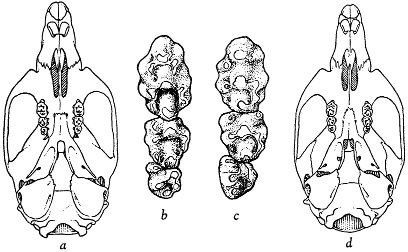University of Kansas Publications
Museum of Natural History
Volume 9, No. 8, pp. 337-346, 1 fig. in text, 1 table
August 15, 1956
Comments on the Taxonomic Status of
Apodemus peninsulae, with Description
of a New Subspecies from North China
BY
J. KNOX JONES, JR.
University of Kansas
Lawrence
1956
University of Kansas Publications, Museum of Natural History
Editors: E. Raymond Hall, Chairman, A. Byron Leonard,
Robert W. Wilson
Volume 9, No. 8, pp. 337-346, 1 fig. in text, 1 table
Published August 15, 1956
University of Kansas
Lawrence, Kansas
PRINTED BY
FERD VOILAND, JR., STATE PRINTER
TOPEKA, KANSAS
1956
26-3854
Comments on the Taxonomic Status of Apodemus peninsulae, with
Description of a New Subspecies from North China
BY
J. KNOX JONES, JR.
In the past several years the United States National Museum has receiveda large number of mammals from central and southern Korea through theauspices of the Commission on Hemorrhagic Fever of the Armed ForcesEpidemiological Board. Among these Korean collections are more than ahundred specimens of a murine rodent originally described as "Micromysspeciosus peninsulae" by Oldfield Thomas but currently placed in thegenus Apodemus. In attempting to ascertain the specific relationshipsof this mouse I have examined, through the generosity of Dr. David H.Johnson, Acting Curator of Mammals, most of the other Oriental specimensof the subgenus Sylvaemus in the U. S. National Museum and it is onthis combined material that the following comments and description arebased.
Three general groups of the genus Apodemus are presently known tooccur on the mainland of northeast Asia. One is the distinctiveApodemus agrarius, lone representative of the subgenus Apodemus. Theothers, both in the subgenus Sylvaemus and closely resembling eachother, are represented by a small animal that is currently regarded asconspecific with Apodemus sylvaticus and a larger animal of which theKorean mouse, peninsulae, is representative. The oldest trivial nameapplied to the large Sylvaemus is major of Radde, 1862, in thecombination [Mus sylvaticus] vrt. major. This is, however, twicepreoccupied (see Ellerman and Morrison-Scott, 1951:566). The nextavailable name is peninsulae of Thomas, 1907, which was applied tomice from central and southern Korea (type from Mun'gyong, 110 mi. SESeoul, Korea), and was originally proposed as a subspecies of theinsular Japanese species, Apodemus speciosus. G. M. Allen (1940:949),who recognized peninsulae as a monotypic species, was the firstinvestigator to make the important distinction that it was notconspecific with the Japanese speciosus, although Hollister (1913:1-2)and Miller (1914:89) had previously used the combination Apodemuspeninsulae, evidently with the same thought in mind.[Pg 340]
 Fig. 1. Ventral views of skulls and left maxillarytooth-rows of two species of t
Fig. 1. Ventral views of skulls and left maxillarytooth-rows of two species of t